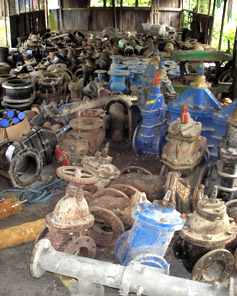Pipeline and asset management
Selection, installation, maintenance, renewal and replacement
 Pipeline and asset management is also fundamental to the process of leakage management, but replacement of mains and services tends to be much more expensive (in $ spent per ML saved) than the other three options described above. The increasing evidence that pressure management can substantially reduce new break frequencies is also the most relevant.
Pipeline and asset management is also fundamental to the process of leakage management, but replacement of mains and services tends to be much more expensive (in $ spent per ML saved) than the other three options described above. The increasing evidence that pressure management can substantially reduce new break frequencies is also the most relevant.
Internationally, many water utilities have tried to reduce their leakage by relying on a high rate of mains replacement; this usually has little effect because in well managed systems, only a minority of annual real losses occurs from reported mains burst (in some cases the real losses increase because other leakage management activities are not being done). Component analysis of annual real losses, using BABE (Ref 4) consistently shows that, in most distribution systems, the majority of Annual Real Losses volume is associated with leaks (background, reported and unreported) on service connections.
Ref 4: Lambert, A.O. Accounting for Losses – the Bursts and Background Estimates Concepts.
Journal of the Institution of Water and Environmental Management, 1994, Volume 8 (2), pp 205-214
 Pipeline and asset management is also fundamental to the process of leakage management, but replacement of mains and services tends to be much more expensive (in $ spent per ML saved) than the other three options described above. The increasing evidence that pressure management can substantially reduce new break frequencies is also the most relevant.
Pipeline and asset management is also fundamental to the process of leakage management, but replacement of mains and services tends to be much more expensive (in $ spent per ML saved) than the other three options described above. The increasing evidence that pressure management can substantially reduce new break frequencies is also the most relevant.Internationally, many water utilities have tried to reduce their leakage by relying on a high rate of mains replacement; this usually has little effect because in well managed systems, only a minority of annual real losses occurs from reported mains burst (in some cases the real losses increase because other leakage management activities are not being done). Component analysis of annual real losses, using BABE (Ref 4) consistently shows that, in most distribution systems, the majority of Annual Real Losses volume is associated with leaks (background, reported and unreported) on service connections.
Ref 4: Lambert, A.O. Accounting for Losses – the Bursts and Background Estimates Concepts.
Journal of the Institution of Water and Environmental Management, 1994, Volume 8 (2), pp 205-214

















